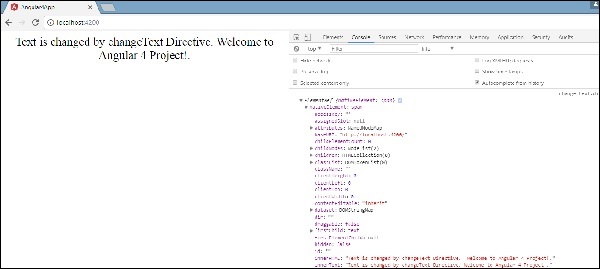- Angular 7指令
- Angular 6-指令(1)
- Angular 6-指令
- Angular 2-指令(1)
- Angular 7指令(1)
- Angular 4-指令(1)
- 角 7 |指令(1)
- 角 7 |指令
- Angular 7 ngIf指令(1)
- Angular 7 ngIf指令
- 后退按钮指令 Angular (1)
- Angular 7 ngStyle指令
- Angular 7 ngStyle指令(1)
- NGINX指令|指令列表
- NGINX指令|指令列表(1)
- Angular 10 NgIf 指令(1)
- Angular 10 NgIf 指令
- Angular 7库(1)
- Angular 7库
- Angular 表单 NgModel 指令
- Angular 表单 NgModel 指令(1)
- 后退按钮指令 Angular - 无论代码示例
- Angular 表单格式货币指令
- Angular 表单格式货币指令(1)
- Angular FormsModule 指令(1)
- Angular FormsModule 指令
- Angular 4-示例
- Angular 4-示例(1)
- Angular 4 和 Angular 5 的区别(1)
📅 最后修改于: 2020-10-28 05:16:54 🧑 作者: Mango
Angular中的指令是一个js类,它声明为@directive 。我们在Angular中有3个指令。指令在下面列出-
组件指令
这些构成了主要类,其中包含有关如何在运行时处理,实例化和使用组件的详细信息。
结构指令
结构指令主要处理操纵dom元素。结构性指令在指令之前带有*符号。例如, * ngIf和* ngFor 。
属性指令
属性指令处理更改dom元素的外观和行为。您可以创建自己的指令,如下所示。
如何创建自定义指令?
在本节中,我们将讨论要在组件中使用的自定义指令。自定义指令由我们创建,不是标准的。
让我们看看如何创建自定义指令。我们将使用命令行创建指令。使用命令行创建指令的命令是-
ng g directive nameofthedirective
e.g
ng g directive changeText
这就是它在命令行中的显示方式
C:\projectA4\Angular 4-app>ng g directive changeText
installing directive
create src\app\change-text.directive.spec.ts
create src\app\change-text.directive.ts
update src\app\app.module.ts
以上文件(即change-text.directive.spec.ts和change-text.directive.ts)已创建,并且app.module.ts文件已更新。
app.module.ts
import { BrowserModule } from '@angular/platform-browser';
import { NgModule } from '@angular/core';
import { AppComponent } from './app.component';
import { NewCmpComponent } from './new-cmp/new-cmp.component';
import { ChangeTextDirective } from './change-text.directive';
@NgModule({
declarations: [
AppComponent,
NewCmpComponent,
ChangeTextDirective
],
imports: [
BrowserModule
],
providers: [],
bootstrap: [AppComponent]
})
export class AppModule { }
上述文件的声明中包含ChangeTextDirective类。该类也从下面给出的文件中导入。
更改文本。指示
import { Directive } from '@angular/core';
@Directive({
selector: '[changeText]'
})
export class ChangeTextDirective {
constructor() { }
}
上面的文件具有指令,并且还具有选择器属性。无论我们在选择器中定义什么,都必须在分配自定义指令的视图中进行匹配。
在app.component.html视图中,让我们如下添加指令:
Welcome to {{title}}.
我们将在change-text.directive.ts文件中写入更改,如下所示:
change-text.directive.ts
import { Directive, ElementRef} from '@angular/core';
@Directive({
selector: '[changeText]'
})
export class ChangeTextDirective {
constructor(Element: ElementRef) {
console.log(Element);
Element.nativeElement.innerText="Text is changed by changeText Directive. ";
}
}
在上面的文件中,有一个名为ChangeTextDirective的类和一个构造函数,该构造函数采用ElementRef类型的元素,该元素是必需的。该元素具有应用了“更改文本”指令的所有详细信息。
我们添加了console.log元素。在浏览器控制台中可以看到相同的输出。元素的文本也如上所述更改。
现在,浏览器将显示以下内容。
